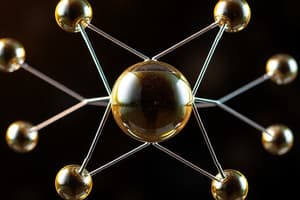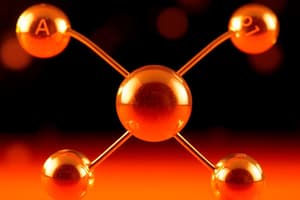Podcast
Questions and Answers
How many valence electrons does chlorine have?
How many valence electrons does chlorine have?
- 7 valence electrons (correct)
- 6 valence electrons
- 8 valence electrons
- 5 valence electrons
What does the number in Bromine-81 indicate?
What does the number in Bromine-81 indicate?
- The number of protons
- The number of electrons
- The number of neutrons
- The atomic mass (correct)
Which of the following isotopes represents the element with an atomic number of 8 and 10 neutrons?
Which of the following isotopes represents the element with an atomic number of 8 and 10 neutrons?
- Oxygen-18 (correct)
- Carbon-10
- Nitrogen-16
- Oxygen-16
What is the proper ionic notation for sulfur after it gains electrons?
What is the proper ionic notation for sulfur after it gains electrons?
Using the data provided, what is the average atomic mass of Element A?
Using the data provided, what is the average atomic mass of Element A?
Flashcards
Bohr Model
Bohr Model
A diagram representing the arrangement of electrons in an atom's energy levels (shells) and sub-levels (orbitals), where electrons orbiting the nucleus are depicted as dots.
Valence Electrons
Valence Electrons
The electrons residing in the outermost shell of an atom, actively involved in chemical bonding.
Ion
Ion
An atom that gains or loses electrons to achieve a stable electron configuration, resulting in a net electrical charge.
Ionic Notation
Ionic Notation
Signup and view all the flashcards
Isotopes
Isotopes
Signup and view all the flashcards
Study Notes
Bohr Models
- Draw Bohr models for elements.
Valence Electrons, Ions, and Ionic Notation
- Identify the number of valence electrons for elements.
- Determine how many electrons an element gains or loses to form an ion.
- Write the resulting ion in proper ionic notation.
- Examples: Sulfur, Chlorine, Calcium, Lithium
Identifying Isotopes
- Determine what a number in an isotopic notation represents.
- Write isotopes in proper notation (example: element with atomic number 8 and 10 neutrons).
- Examples: Element with 26 protons and 32 neutrons, Bromine-81.
Calculating Average Atomic Mass of Isotopes
- Understand the formula used to calculate average atomic mass.
- Calculate the average atomic mass from provided data (percentage abundance and mass of isotopes).
- Example calculation: Using data of element A isotopes to calculate the average atomic mass.
Studying That Suits You
Use AI to generate personalized quizzes and flashcards to suit your learning preferences.
Description
This quiz covers essential concepts in atomic structure, focusing on Bohr models, valence electrons, ionic notation, and isotopes. You will engage in identifying elements' valence electrons, writing isotopes, and calculating average atomic mass using provided data. Test your understanding of these foundational chemistry principles.




